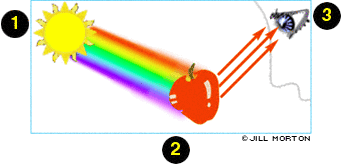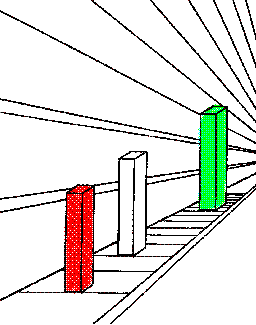|
Perception
is the process by which we interpret and organize sensation to produce
a meaningful experience of the world.
Sensation usually refers to the immediate, relatively unprocessed result
of stimulation of sensory receptors in the eyes, ears, nose, tongue, or
skin.
Perception better describes one's ultimate experience of the world and
typically involves further processing of sensory input. In practice, sensation
and perception are virtually impossible to separate, because they are
part of one continuous process.
Our sense organs translate physical energy from the environment into electrical impulses processed by the brain. For example, light, in the form of electromagnetic radiation, causes receptor cells in our eyes to activate and send signals to the brain. But we do not understand these signals as pure energy. The process of perception allows us to interpret them as objects, events, people, and situations.
Without
the ability to organize and interpret sensations, life would seem like
a meaningless jumble of colors, shapes, and sounds. A person without any
perceptual ability would not be able to recognize faces, understand language,
or avoid threats. Such a person would not survive for long. In fact, many
species of animals have evolved exquisite sensory and perceptual systems
that aid their survival.
How the Eye Sees Color
Color originates in light. Sunlight, as we perceive it, is colorless. In reality, a rainbow is testimony to the fact that all the colors of the spectrum are present in white light. As illustrated in the diagram below, light goes from the source (the sun) to the object (the apple), and finally to the detector (the eye and brain).
 |
1. All the invisible colors of sunlight shine on the apple.
2. The surface of a red apple absorbs all the colored light rays, except for those corresponding to red, and reflects this color to the human eye.
3. The eye receives the reflected red light and sends a message to the brain.
Check out this Perspective Illusion
 |
Which
colored block appears the largest and which the smallest? Take a ruler
and measure them, you may be surprised at what you find. I hope you measured the blocks. If you did you will have noticed that they are all the same size. Why then do they appear to increase in size as they get further away? Think about it. Maybe you can guess why. Take close look at the pattern on the floor, walls and ceiling. Can you see how they tend to converge on to a common point in the distance? This is called perspective. The further way objects are the smaller the visual angle they subtend on the retina. However, if you were actually standing in the hallway containing the blocks the floor pattern and those on the walls and ceiling would not seem to converge. Another example is when you stand in the middle of rail road tracks (beware of trains) the parallel tracks continue to appear parallel for a long way into the distance even though they project onto your retina in perspective. |
| [ home| perception| depth perception| context effects| 3D vision ] |
| [ autostereogram| effects of color| optical illusions| visual illusions ] |

